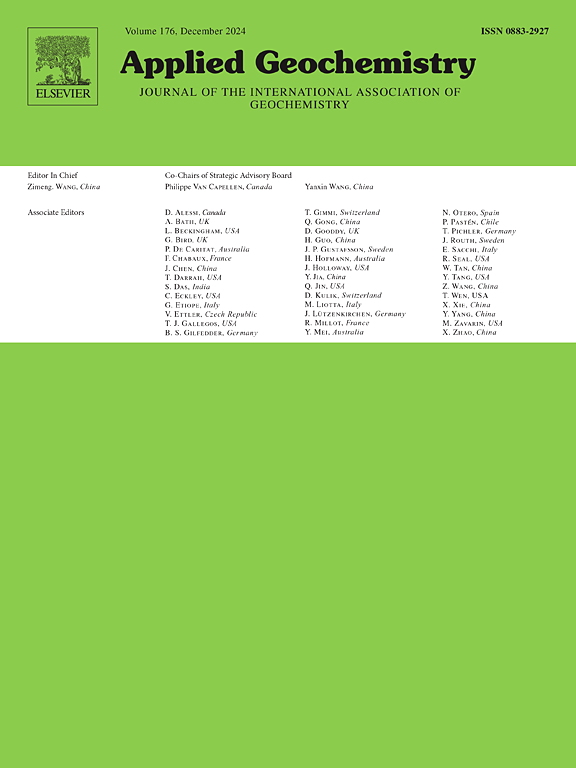黄河下游河漫滩浅层中溶解硫酸盐成因及贡献比例的地球化学和同位素(氧、氢、硫)指标
IF 3.1
3区 地球科学
Q1 GEOCHEMISTRY & GEOPHYSICS
引用次数: 0
摘要
地下水中硫酸盐(SO42−)污染已成为鲁西南黄河下游漫滩地区的主要公共卫生威胁。本研究收集了72个浅层地下水样本、18个地表水样本和21个工业废水样本(其中包括4个用于分析煤矿开采影响的矿井水样本)来研究水环境中硫酸盐的来源。结合SO42−(δ34S和δ18O)和H2O (δD和δ18O)的水化学和同位素数据以及R (SIMMR)稳定同位素混合模型,确定了不同流域的硫酸盐来源和各来源的比例。结果表明:化肥是大部分地区地表水中硫酸盐的主要来源,而粪肥和大气沉降是地下水中硫酸盐的主要来源。嘉祥和运城县南部地表水和地下水中蒸发岩溶蚀对硫酸盐的贡献最为显著。在工业活动密集的地区,工业污水对水体的贡献也相当大。朱昭新河下游的巨野、嘉祥两县地下水受矿井排水影响最为严重。水文地质环境和人为活动共同控制了水中硫酸盐的含量。该研究不仅为其他硫酸盐污染地区的类似研究提供了有用的方法和线索,而且说明了水文地球化学和同位素监测对水资源可持续管理的重要性。本文章由计算机程序翻译,如有差异,请以英文原文为准。

Geochemical and isotopic (oxygen, hydrogen, sulfur) indicators constraining the origin and contribution ratios of dissolved sulfate in shallow aquifers from the lower Yellow River floodplain, northern China
Sulfate (SO42−) contamination of groundwater is becoming a major public health threat in the lower Yellow River floodplain of southwest Shandong Province. In this study, 72 shallow groundwater samples, 18 surface water samples and 21 industrial wastewater samples (including 4 mine drainage samples used to analyze the effects of coal mining activities) were collected to investigate the origins of sulfate in the water environment. Hydrochemical and isotopic data of SO42− (δ34S and δ18O) and H2O (δD and δ18O) as well as stable isotope mixing models in R (SIMMR) were integrated to identify the sulfate sources and the proportions of each source in different watersheds. The results showed that chemical fertilizer is the dominant source of sulfate in surface water in most of the area, while manure and atmospheric deposition are the main sources of sulfate in groundwater. The contributions of evaporites dissolution to sulfate are most significant in surface water and groundwater in Jiaxiang and southern Yuncheng counties. In areas with intensive industrial activities, the contribution of industrial sewage to water bodies is also considerable. The groundwater in Juye and Jiaxiang Counties in the downstream of Zhuzhaoxin River is worst affected by mine drainage. The hydrogeological setting and anthropogenic activities jointly controlled the sulfate in the water. The research not only provide useful methodology and clues for similar studies in other sulfate contaminated areas, but also exemplify the vital importance of hydrogeochemical and isotopic monitoring for the sustainable management of water resources.
求助全文
通过发布文献求助,成功后即可免费获取论文全文。
去求助
来源期刊

Applied Geochemistry
地学-地球化学与地球物理
CiteScore
6.10
自引率
8.80%
发文量
272
审稿时长
65 days
期刊介绍:
Applied Geochemistry is an international journal devoted to publication of original research papers, rapid research communications and selected review papers in geochemistry and urban geochemistry which have some practical application to an aspect of human endeavour, such as the preservation of the environment, health, waste disposal and the search for resources. Papers on applications of inorganic, organic and isotope geochemistry and geochemical processes are therefore welcome provided they meet the main criterion. Spatial and temporal monitoring case studies are only of interest to our international readership if they present new ideas of broad application.
Topics covered include: (1) Environmental geochemistry (including natural and anthropogenic aspects, and protection and remediation strategies); (2) Hydrogeochemistry (surface and groundwater); (3) Medical (urban) geochemistry; (4) The search for energy resources (in particular unconventional oil and gas or emerging metal resources); (5) Energy exploitation (in particular geothermal energy and CCS); (6) Upgrading of energy and mineral resources where there is a direct geochemical application; and (7) Waste disposal, including nuclear waste disposal.
 求助内容:
求助内容: 应助结果提醒方式:
应助结果提醒方式:


